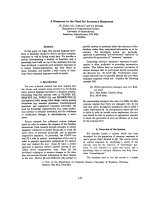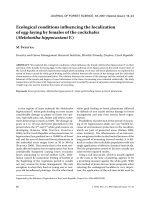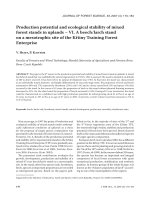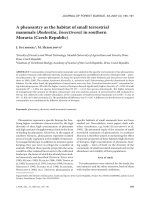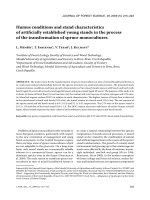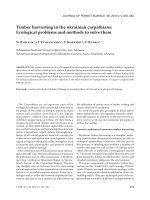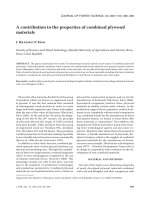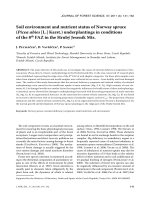Báo cáo lâm nghiệp: " A contribution to the properties of combined plywood materials" ppsx
Bạn đang xem bản rút gọn của tài liệu. Xem và tải ngay bản đầy đủ của tài liệu tại đây (736.72 KB, 8 trang )
J. FOR. SCI., 53, 2007 (10): 483–490 483
JOURNAL OF FOREST SCIENCE, 53, 2007 (10): 483–490
A contribution to the properties of combined plywood
materials
J. H, P. K
Faculty of Forestry and Wood Technology, Mendel University of Agriculture and Forestry Brno,
Brno, Czech Republic
ABSTRACT: e paper summarizes the results of institutional research aimed at new types of combined plywood
materials. Under pilot plant conditions, three variants of combined plywood materials were pressed, namely with the
layer of fibreglass, with a core cork layer and with a cork wear layer on one side of the plywood surface and a cork core.
Tests of selected physical and mechanical properties were carried out on these materials including the basic statistical
evaluation. Comparisons with plywood materials Multiplex 15 and 20 mm in thickness were also made.
Keywords: combined plywood; density; moisture; bending strength; modulus of elasticity in bending; statistical analysis;
cork core; fibreglass surface
Supported by the Ministry of Education, Youth and Sports of the Czech Republic, Project No. MSM 6515648902.
Plywood is often named as the first from the group
of products which are known as engineered wood
at present. It was the first material that consisted
of disintegrated wood particles in order to create
larger and solid composite units, firmer and tougher
than the sum of the values of their parts (H,
K 2005). At the end of the 70s and at the begin-
ning of the 80s of the 20
th
century, the principle
of plywood allowed the origin of OSB (oriented
structural boards). Other products from the group
of engineered wood are: Parallam PSL, Intrallam
LSL, Microllam LVL and TJI beams. ese products
combine properties of wood, also making it possible
to use valuable natural resources more economically
(B et al. 1996; S, S 1991).
In addition to their static function combined ply-
wood materials show various special functions, e.g.
thermal and insulating ones. rough the combina-
tion of these two requirements a material originates
which is more advantageous compared to the use
of separate materials (K, H 2006). is
advantage consists not only in the price area but
also in the simplicity of production technologies
and production productivity. Combined plywood
materials are not manufactured in such a volume as
plywood for construction purposes and e.g. for the
manufacture of formwork (H, K 2004).
Specialized companies produce these plywood
materials in smaller custom-made volumes. In the
production range of these companies, sandwich ele-
ments occur completely without wood components
(e.g. combined boards for the manufacture of doors
into passive houses, ice boxes) or these firms offer
these materials as “specialities”. Nevertheless, the
manufacture of these materials is much more exact-
ing from technological aspects and also more ex-
pensive. erefore, their market has to be ensured in
advance. A Finnish manufacturer of plywoods, Ko-
skisen Company, which is the supplier of combined
plywood materials for the manufacture of lorries,
can serve as an example. is firm has a development
team (PDT – Plywood Development Team) who is
in charge of cooperation with consumers at the de-
velopment of new combined materials.
MATERIAL AND METHODS
e aim of the study was to determine properties
of newly developed plywood materials combined
with cork and fibreglass and their comparison with
484 J. FOR. SCI., 53, 2007 (10): 483–490
standard plywoods – multiplexes, and comparison
with properties of similar materials produced by
reputable companies (K, H 2003).
Flexural load occurs in a number of technical
applications of plywoods. e exact knowledge of
required values of flexural load for the particular
types of use makes it possible to design plywoods of
optimum construction. Physical (density, moisture)
and mechanical (bending strength, modulus of elas-
ticity in bending, glue-bond strength, shear strength
in Variant 2) properties were determined. e ob-
tained values were processed by description statistics.
e selection of samples, determination of bending
strength and modulus of elasticity at the bending of
plywoods as well as related properties were carried
out according to the following ČSN EN standards:
– ČSN EN 326 – 1 Boards of wood. Sampling, cut
-
ting and inspection. Part 1: Sampling, cutting
specimens and the formulation of test results
– ČSN EN 325 Determination of specimen dimen
-
sions
– ČSN EN 310 Determination of the modulus of
elasticity in bending and bending strength
– ČSN EN 322 Determination of moisture
– ČSN EN 323 Determination of density
– ČSN EN 314 – 2 Requirements for the quality of
gluing plywoods.
From each of the plywoods, 12 test specimens were
cut to determine bending strength (6 specimens
in longitudinal direction, 6 in cross direction), 6 to
determine density, 6 to determine moisture and in
Variant 2, 6 specimens to determine shear strength
(glue-bond strength). In the paper it is calculated with
one-dimensional bending of orthotropic material.
Bending strength and modulus of elasticity in
bending were determined using a test machine
ZWICK, model Allround, measuring range 10-20-
30-50-100 kN.
Material – variants and the structure
of plywoods
Variant 1– plywood with fibreglass (11-ply,
thickness 16 mm)
Structure:
– phenolic foil,
– 11-ply plywood (11 × beech veneer 1.5 mm
thick),
– non-woven fibreglass,
– phenolic foil.
A layer of fibreglass was laid on previously pressed
11-ply plywood. e plywood was then two-side
coated using a phenolic foil. e unit was pressed
using the following pressing parameters:
– gluing AW 100 (PF adhesive),
– working pressure 1.5 MPa,
– working temperature 125°C.
Variant 2 – plywood with a cork core
(11-ply, thickness 22 mm)
Structure:
– 5-ply plywood (beech 1.5; spruce 2.5; beech 2.5;
spruce 2.5; beech 1.5 mm),
– cork core, thickness 3 mm,
– 5-ply plywood (beech 1.5; spruce 2.5; beech 2.5;
spruce 2.5; beech 1.5 mm).
For the manufacture, previously pressed plywoods
10 mm thick were used and a cork layer was inserted
between them. e unit was pressed using the fol-
lowing pressing parameters:
– gluing IF 20 (UF adhesive),
– working pressure 0.4 MPa,
– working temperature 110–120°C.
Fig. 1. Variant 1 – plywood with fibreglass (11-ply, thickness
16 mm)
Fig. 3. Plywood with a cork core and a cork wear layer (12-ply,
thickness 25 mm)
Fig. 2. Plywood with a cork core (11-ply, thickness 22 mm)
J. FOR. SCI., 53, 2007 (10): 483–490 485
Variant 3 – plywood with a cork core and a cork
wear layer (12-ply, thickness 25 mm)
Structure:
– cover (top) cork layer, thickness 3 mm,
– 5-ply plywood (beech 1.5; spruce 2.5; beech 2.5;
spruce 2.5; beech 1.5 mm),
– cork core, thickness 3 mm,
– 5-ply plywood (beech 1.5; spruce 2.5; beech 2.5;
spruce 2.5; beech 1.5 mm).
For the manufacture, previously pressed plywoods
10 mm thick were used and a cork interlayer was
inserted between them. Another cork layer was laid
on one upper side. e unit was pressed using the
following pressing parameters:
– gluing IF 20 (UF adhesive),
– working pressure 0.4 MPa,
– working temperature 110–120°C.
All materials were pressed using a laboratory press
700 × 700 mm in size, sampling was carried out ac-
cording to the ČSN EN 326 –1 standard.
Determination of modulus of elasticity
and bending strength according to ČSN EN 310
e method consists in the loading of a sample
that is suspended on two supports whereas the sin-
gle loading interacts in the middle of sample (Figs.
4 and 5).
During the test the width and thickness of the
sample, and the distance of supports are measured,
and deflection at loading and maximal faulted load-
ing are determined.
Modulus of elasticity is calculated from the linear
section of the loading-deflection curve and from
the distance of supports, width and thickness of the
sample. e calculated value is apparent, not the real
modulus of elasticity, because the testing method
covers also shear besides bending. Bending strength
of each sample is calculated as the quotient of bend-
ing moment M at maximal loading of the sample F
max
to the moment of its integral profile.
e loading force acts with constant feed speed
in the process of testing. e loading speed is such
that maximal loading will be attained at (60 ± 30) s.
Deflection in the middle of the sample (under the
loading head) is measured to the nearest 0.1 mm.
is value is plotted in a diagram with corresponding
loading measured with 1% exactness.
e materials in variant 1–3 were not evaluated
in this part of research project from the aspect of
separate layers, consequently the modulus of elas-
ticity and bending strength of separate layers were
not analyzed.
Formulation of test results
Modulus of elasticity E
m
:
l
3
1
(F
2
– F
1
)
E
m
= ––––––––––––
4bt
3
(a
2
– a
1
)
where: l
1
– distance between the centres of supports
(mm),
b – width of sample (mm),
t – thickness of sample (mm),
F
2
– F
1
– load increment in the straight line of load-
ing diagram (N); F
1
has to be approximately
10%, F
2
40% of maximal loading,
a
2
– a
1
– increase in the deflection of the sample at
the point of load force (mm), adequate to
loading increment (F
2
– F
1
).
e modulus of elasticity of each sample has to
be definited with effect for three significant decimal
positions.
Fig. 4. e principle of measuring the
modulus of elasticity and bending
strength
Fig. 5. Loading diagram for the determination of modulus of
elasticity
0.4 F
max
0.1 F
max
F
2
F
1
a)
↑
a
1
b)→
a
2
486 J. FOR. SCI., 53, 2007 (10): 483–490
Bending strength f
m
:
3F
max
l
1
f
m
= –––––––––
2bt
2
where: F
max
– loading of sample at failure (N),
l
1
– distance between the centres of supports
(mm),
b – width of sample (mm),
t – thickness of sample (mm).
e bending strength of each sample has to be
definited with effect for three significant decimal
positions.
RESULTS
Five boards were pressed from each of the variants
of combined plywoods (1–3). Selected physical and
mechanical properties were determined according to
ČSN EN standards. Because it was not the routine
series production, the particular boards of variants
1–3 were not evaluated separately and compared
with one another, but within each of the variants all
plywoods (1–5) were evaluated as one set (n = 30).
Table 2. Bending strength f
m
and modulus of elasticity E
m
along the grain (N/mm
2
) – ČSN EN 310
Property
Multiplex 20 mm thick Multiplex 15 mm thick
f
m
E
m
f
m
E
m
m 88.63 9,464.5 102.68 10,636.88
s 9.90 411.05 6.27 781.21
L
5%
69.92 8,687.62 90.82 9,160.38
V (%) 0.34 4.34 6.11 7.34
Table 1. Bending strength f
m
and modulus of elasticity E
m
along the grain (N/mm
2
) – ČSN EN 310
Property Variant 1 Variant 2 Variant 3
f
m
E
m
f
m
E
m
f
m
E
m
m 112.34 1,1406.5 46.07 5,191.25 41.15 2,142.58
s 10.68 560.11 3.92 269.26 2.40 230.46
L
5%
92.15 1,0347.89 38.66 4,682.34 36.61 1,707.01
V (%) 9.51 4.91 8.51 5.19 5.84 10.76
2.50E + 03
2.00E + 03
1.50E + 03
1.00E + 03
5.00E + 02
0.00E + 00
0.00E + 00 4.00E + 00 8.00E + 00 1.20E + 01 1.60E + 01
2.00E + 00 6.00E + 00 1.00E + 01 1.40E + 01 1.80E + 01
Deflection (mm)
Version I
Multiplex 15 mm
Force (N)
3.50E + 03
3.00E + 03
2.50E + 03
2.00E + 03
1.50E + 03
1.00E + 03
5.00E + 02
0.00E + 00
0.00E + 00 4.00E + 00 8.00E + 00 1.20E + 01 1.60E + 01 2.00E + 01
2.00E + 00 6.00E + 00 1.00E + 01 1.40E + 01 1.80E + 01
Deflection (mm)
Version I
Multiplex 15 mm
Force (N)
Fig. 6. Comparison of the course
of force and deflection – bending
strength across the grain – Vari-
ant 1
Fig. 7. Comparison of the course
of force and deflection – bending
strength along the grain – Va-
riant 1
J. FOR. SCI., 53, 2007 (10): 483–490 487
Basic descriptive statistics were computed: arith-
metic mean m, standard deviation s, coefficient of
variation V, lower fractile of normal distribution L
5%
.
Tables 1 to 7 show the results of tests of physical and
mechanical properties of the following combined
plywoods:
Variant 1 – Plywood with fibreglass (11-ply, thick-
ness 16 mm)
Variant 2 – Plywood with a cork core (11-ply, thick-
ness 22 mm)
Variant 3 – Plywood with a cork core and a cork wear
layer (12-ply, thickness 25 mm).
And for the purpose of comparison:
Multiplex 20 mm thick
Multiplex 15 mm thick.
At this test, the rupture of a cork layer occurred in all
test specimens without the exposure of a glue line.
Figs. 6 to 9 illustrate the course of force and deflec-
tion at the determination of bending strength along
the grain and across the grain in Variants 1 and 3.
Fig. 12 illustrates the course of tension in separate
layers in pressure and tensile in bending: (a) along
the grain of outer veneers, (b) across the grain of
outer veneers.
DISCUSSION
Combined plywoods with fibreglass (Variant 1) are
intended exclusively for floors of lorries and other
vehicles, for constructions of platforms, industrial
floors etc. From the aspect of the indicated use bend-
ing strength and modulus of elasticity in bending are
important properties. On the basis of tests of the
properties and comparing properties of Multiplex
boards it is possible to conclude that all materials
under examination have nearly the same bending
strength (Tables 1 to 4).
No significant effects of fibreglass on bending
strength and modulus of elasticity in bending (MOE)
were proved. However, it is possible to suppose the
3.50E + 03
3.00E + 03
2.50E + 03
2.00E + 03
1.50E + 03
1.00E + 03
5.00E + 02
0.00E + 00
0.00E + 00 5.00E + 00 1.00E + 01 1.50E + 01 2.00E + 01 2.50E + 01 3.00E + 01
Deflection (mm)
Version III
Multiplex 20 mm
Force (N)
3.50E + 03
3.00E + 03
2.50E + 03
2.00E + 03
1.50E + 03
1.00E + 03
5.00E + 02
0.00E + 00
0.00E + 00 4.00E + 00 8.00E + 00 1.20E + 01 1.60E + 01
2.00E + 00 6.00E + 00 1.00E + 01 1.40E + 01 1.80E + 01
Deflection (mm)
Version III
Multiplex 20 mm
Force (N)
Fig. 8. Comparison of the course
of force and deflection – bending
strength along the grain – Vari-
ant 3
Fig. 9. Comparison of the course
of force and deflection – bending
strength across the grain – Vari-
ant 3
120
100
80
60
40
20
0
Bending strength – MOR (N/mm
2
)
Version I Version II Version III Multiplex Multiplex
20 mm 15 mm
MOR longitudinal MOR transversely
Fig. 10. Comparison of the bending strength of combined
plywoods, Variants 1–3
488 J. FOR. SCI., 53, 2007 (10): 483–490
effects of fibreglass on abrasive resistance and de-
creased combustibility of combined plywood mate-
rials. Determination of these parameters will be the
subject of further research.
It is supposed that combined plywoods with a cork
core (Variant 2) will be used in the construction of
rail and road vehicles where the sound insulation
of inner spaces (interior) is important. e bending
strength of these boards as compared with Multi-
plex boards 20 mm thick is markedly lower (Tables
1–4 and Figs. 10–11). The value of the bending
strength of plywoods with a cork core along the grain
(46.07 N/mm
2
) and across the grain (35.95 N/mm
2
)
is sufficient for intended purposes. is value can
be, however, increased using beech veneers instead
of spruce veneers in the whole construction of ply-
woods. e density of plywoods significantly affects
the capacity of the material to dampen noise. To
achieve good sound-proof properties materials of a
density of 630 kg/m
3
are ordinarily used (e.g. Polyvan
31, sound attenuation 33 dB). erefore, it is suitable
to think about increased density roughly to this value
even in combined plywoods with a cork core.
It is also possible to replace spruce veneers by
beech veneers in the whole construction. Determi-
nation of sound-proof properties will be the subject
of next research. e quality of gluing was satisfac-
tory, the disturbance of test specimens occurred
always in the layer of cork because its shearing
strength was low.
Combined plywoods with a cork wear layer
(Variant 3) show a similar purpose of use as the
Table 4. Bending strength f
m
and modulus of elasticity E
m
across the grain (N/mm
2
) – ČSN EN 310
Property
Multiplex 20 mm thick Multiplex 15 mm thick
f
m
E
m
f
m
E
m
m 85.67 8,121.13 87.52 8,719.60
s 6.92 403.60 16.39 1,239.43
L
5%
72.59 7,358.32 57.53 6,451.44
V (%) 0.24 4.97 0.75 14.21
Table 5. Density of combined plywoods (kg/m
3
) – ČSN EN 323
Property Variant 1
Variant 2
density ρ
Variant 3
m 815.88 592.12 565.74
s 10.97 9.61 9.80
L
5%
795.14 573.96 547.22
V (%) 1.34 1.62 1.73
Table 3. Bending strength f
m
and modulus of elasticity E
m
across the grain (N/mm
2
) – ČSN EN 310
Property
Variant 1 Variant 2 Variant 3
f
m
E
m
f
m
E
m
f
m
E
m
m 83.82 7,955.75 35.95 5,386.83 33.58 2,263.17
s 3.27 346.36 7.68 530.16 4.33 258.89
L
5%
77.93 7,332.30 22.12 4,432.55 25.79 1,797.17
V (%) 3.90 4.35 21.37 9.84 12.89 11.44
12,000
10,000
8,000
6,000
4,000
2,000
0
Modulus of elasticity – MOE (N/mm
2
)
Version I Version II Version III Multiplex Multiplex
20 mm 15 mm
Fig. 11. Comparison of the modulus of elasticity in bending of
combined plywoods, Variants 1–3
MOE longitudinal MOE transversely
Table. 6. Moisture of combined plywoods (%) – ČSN EN 322
Property Variant 1
Variant 2
moisture H
Variant 3
m 5.04 5.24 5.79
s 1.21 0.98 0.14
L
5%
2.74 3.38 5.51
V (%) 24.09 18.76 2.49
Table 7. Shearing strength test of a cork layer (N/mm
2
) – ČSN
EN 314-2
Property
Variant 2
τ
m 0.49
s 0.04
L
5%
0.43
V (%) 7.26
J. FOR. SCI., 53, 2007 (10): 483–490 489
previous type. ey can be used for floor elements
with a cork wear layer. However, this layer has to
be surface-finished. Changes in properties in this
type of material compared to combined plywood
with a cork core can be observed only in density,
which is logical. e volume of the plywood in-
creased (thickness), however, the weight increased
only slightly because cork is very light. Surface
density, however, increased from 13.02 kg/m
2
to
14.41 kg/m
2
.
CONCLUSION
e aim of the paper was to determine properties
of newly developed plywood materials combined
with cork and fibreglass and to compare them with
common plywoods, viz. multiplexes. ese newly
developed plywood materials were also compared
with similar materials produced by renowned com-
panies. Under pilot plant conditions, three vari-
ants of combined plywood materials were pressed,
namely with a layer of fibreglass, with a cork core
layer and with a cork wear layer on one side of the
plywood board and a cork core. Tests of selected
physical and mechanical properties were carried
out on these materials including basic statistical
evaluation. A comparison with plywood materials
Multiplex 15 and 20 mm thick was also made. As for
the pressed variants of combined plywood materi-
als (I–III) only plywoods combined with fibreglass
(Variant I) reach the required values of mechanical
properties of Multiplex boards 15 and 20 mm thick.
Plywoods with a cork layer (Variants II and III) show
lower strength properties.
Within this research, the following parameters
were not examined:
– the surface resistance with the Taber apparatus in
plywoods with fibreglass;
– the surface resistance by a rolling test which
simulates the passage of a cart for plywoods with
fibreglass;
– noise attenuation in both types of plywoods with
cork;
– attenuation of footfall sound in plywood with a
cork surface layer.
e refraction of materials in the whole profile
and also in separate layers was not examined. e
failure of materials at separate layer interface ow-
ing to shear in bending oneself partially approved.
is is again a theme of another research inclusive
of determination of the elastic constant according
to separate layers.
Appropriate tests to determine parameters men-
tioned above will be the subject of follow-up re-
search.
Re fe re nc es
BAO Z., ECKELMAN C., GIBSON H
., 1996. Fatigue strength
and allowable design stresses for some wood compos-
ites used in furniture. Holz als Roh und Werkstoff, 54:
377–382.
HRÁZSKÝ J., KRÁL P., 2004.
Analysis of properties of
boards for concrete formwork. Journal of Forest Science,
50: 382–398.
HRÁZSKÝ J., KRÁL P.,
2005. Effects of the thickness of ro-
tary-cut veneers on properties of plywood sheets. Part 1.
Compressibility of plywood materials. Journal of Forest
Science, 51: 313–321.
KRÁL P., HRÁZSKÝ J., 2003.
Effect of negative factors on
the use of oak and beech. Journal of Forest Science, 49:
281–289.
KRÁL P., HRÁZSKÝ J., 2006.
Effects of different pressing
conditions on properties of spruce plywoods. Journal of
Forest Science, 52: 285–292.
SHARP D.J., SUDDARTH S.K., 1991
. Volumetric effects in
structural composite lumber. In: Proceedings, 1991 Inter-
national Timber Engineering Conference, 1991 September
2–5, London, 3: 427–437.
Received for publication June 6, 2007
Accepted after corrections July 11, 2007
Fig. 12. Diagram of the course of tension in separate layers in
pressure and tensile in bending
(a) along the grain of outer veneers, (b) across the grain of
outer veneers
(a)
(b)
490 J. FOR. SCI., 53, 2007 (10): 483–490
Příspěvek k vlastnostem kombinovaných překližovaných materiálů
ABSTRAKT: V článku jsou shrnuty výsledky institucionálního výzkumu zaměřeného na nové typy kombinovaných
překližovaných materiálů. V poloprovozních podmínkách byly odlisovány tři varianty kombinovaných překližovaných
materiálů, a to s vrstvou skelného vlákna, s jádrovou korkovou vrstvou a s korkovou nášlapnou vrstvou na jedné
straně povrchu překližované desky a korkovým jádrem. Na těchto materiálech byly provedeny zkoušky vybraných
fyzikálních a mechanických vlastností včetně základního statistického vyhodnocení. Bylo rovněž provedeno srovnání
s překližovanými materiály Multiplex o tloušťce 15 a 20 mm.
Klíčová slova: kombinovaná překližka; hustota; vlhkost; pevnost v ohybu; modul pružnosti v ohybu; statistická
analýza; korkové jádro; povrch se skelným vláknem
Corresponding author:
Doc. Dr. Ing. J H, Mendelova zemědělská a lesnická univerzita v Brně, Lesnická a dřevařská fakulta,
Lesnická 37, 613 00 Brno, Česká republika
tel.: + 420 545 134 159, fax: + 420 545 134 157, e-mail:
